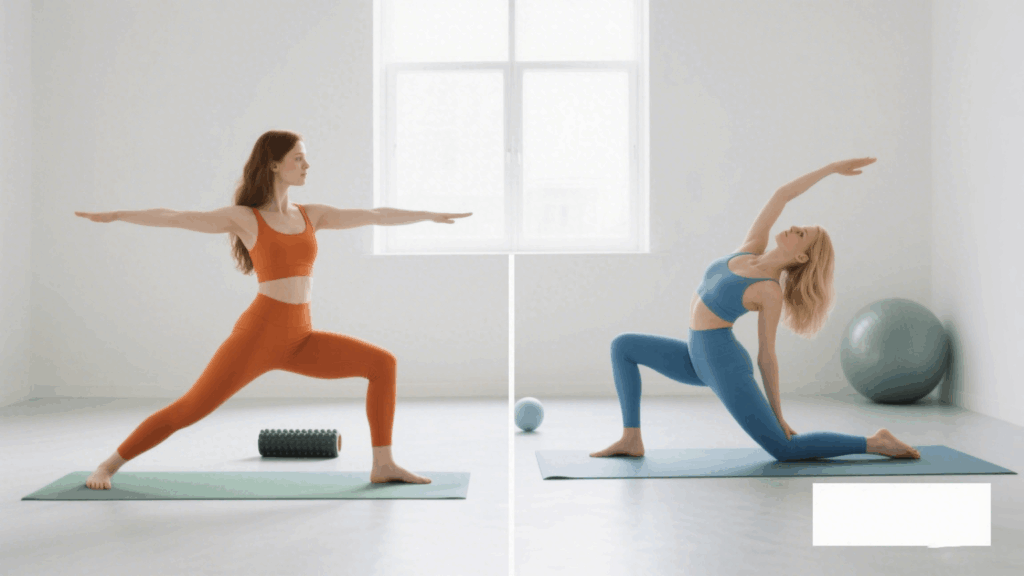
In today’s wellness-focused world, many people are turning to low-impact exercises that nurture both the body and the mind. Two popular disciplines often recommended for strength, flexibility, and inner peace are yoga and Pilates. Though they may appear similar at first glance, these two practices are fundamentally different in origin, purpose, and technique. Choosing between them depends on understanding these differences and how they align with your personal health goals.
I. Origins and Core Philosophies
To truly understand the yoga vs pilates difference, it’s important to begin with their origins. Yoga dates back thousands of years to ancient India. Rooted in spiritual and philosophical traditions, yoga was originally developed as a holistic path to enlightenment. Its practices include physical postures (asanas), breathing exercises (pranayama), and meditation.
Pilates, on the other hand, is a relatively modern exercise system created in the early 20th century by Joseph Pilates. Originally designed for rehabilitation and physical conditioning, Pilates focuses primarily on core strength, posture, alignment, and controlled movement. It doesn’t have the spiritual or meditative roots found in yoga, but it emphasizes mind-body awareness through precision and breath control.
In essence, yoga integrates a spiritual and meditative element into its physical practice, while Pilates emphasizes body mechanics and muscular control. This fundamental divergence shapes the entire experience of each practice.
II. Physical and Mental Benefits
Both yoga and Pilates offer remarkable health benefits, but they differ in what they emphasize. When evaluating the yoga vs pilates difference, consider the specific physical and mental outcomes each provides.
Yoga is known for improving flexibility, balance, and joint mobility. Regular practice can increase circulation, relieve chronic stress, reduce anxiety, and enhance mindfulness. Styles vary widely, from restorative and gentle Yin Yoga to more physically intense styles like Vinyasa or Power Yoga. It’s especially effective for those seeking a calming, spiritually enriching routine that supports overall well-being.
Pilates is highly effective for developing core strength, improving posture, and addressing muscular imbalances. It’s often used in physical therapy and athletic training due to its low-impact but highly targeted approach. The controlled movements enhance muscular endurance, spinal alignment, and coordination, making it ideal for those recovering from injury or seeking a strong, toned physique.
While both promote better body awareness and stress relief, yoga often leads with flexibility and mental clarity, whereas Pilates emphasizes strength and structural support.
III. Choosing the Right Practice for Your Needs
When making your decision, it helps to reflect on your current fitness level, any physical limitations, and what you’re hoping to achieve.
If you’re looking for a workout that enhances flexibility, incorporates meditation, and brings emotional calm, yoga may be your ideal fit. It’s accessible to people of all fitness levels and can easily be practiced at home or in studios. Yoga is also adaptable to specific goals, whether it’s stress reduction, injury recovery, or enhancing athletic performance.
On the other hand, if your primary goal is to build core strength, correct posture, or rehabilitate an injury, Pilates might serve you better. Mat Pilates requires minimal equipment, while reformer Pilates offers resistance for greater challenge. The precision and control involved in Pilates make it a great option for those who prefer a structured, technical workout.
For many, the best approach is a combination of both. Integrating yoga’s flexibility and mindfulness with Pilates’ strength and alignment training creates a well-rounded routine that supports the body and mind.
Final Thoughts
The yoga vs pilates difference is more than a matter of style—it’s about your individual goals, preferences, and needs. Yoga excels in promoting flexibility and mental wellness, while Pilates is ideal for strength, structure, and physical rehabilitation. By understanding these distinctions, you can choose a practice that aligns with your lifestyle and sets you on a path to lasting health and balance.
Whether you find solace in a quiet yoga flow or prefer the focused engagement of Pilates, the most important thing is consistency and joy in the movement. Explore both, listen to your body, and commit to the journey that suits you best.
